Social Research Report on School Dropouts: Bhutan's Stakeholders
VerifiedAdded on 2021/06/15
|28
|6200
|77
Report
AI Summary
This social research report investigates the increasing rate of school dropouts at Drametse Central School in Bhutan, focusing on the remote community's perspective and the resulting consequences for stakeholders. The study employs constructivist and interpretivist approaches, utilizing both primary and secondary data sources and a random probability sampling method to understand the reasons behind dropouts. The research aims to identify causes, suggest measures for stakeholders to reduce dropout rates, and emphasize the importance of education in the community. The report includes a literature review, research methodology, timeline, and budget, providing a comprehensive overview of the issue and potential solutions. The study highlights the impact of poverty, illiteracy, and primitive thoughts on education, emphasizing the need for awareness among stakeholders to improve student retention and promote educational development in the region.
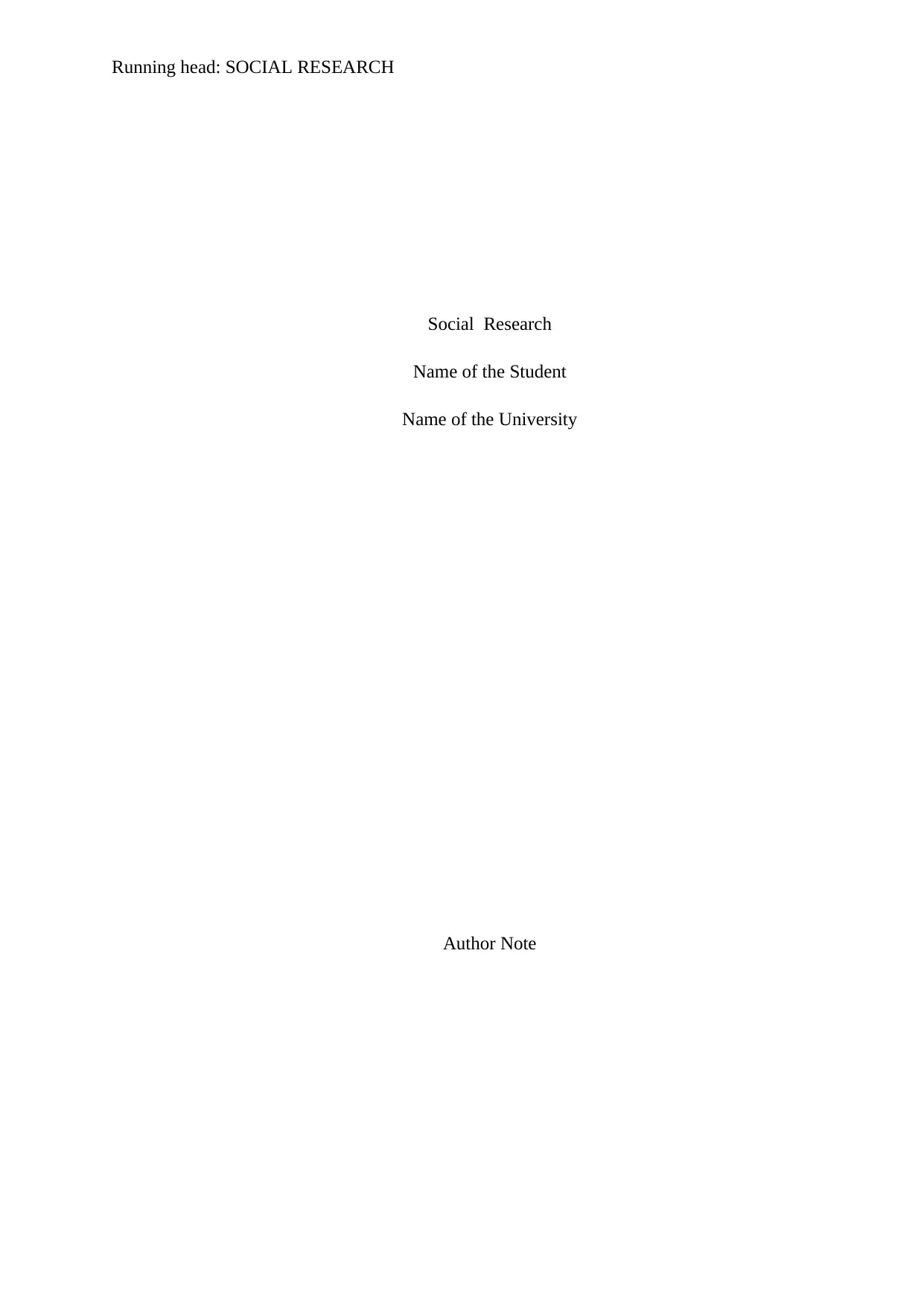
Running head: SOCIAL RESEARCH
Social Research
Name of the Student
Name of the University
Author Note
Social Research
Name of the Student
Name of the University
Author Note
Paraphrase This Document
Need a fresh take? Get an instant paraphrase of this document with our AI Paraphraser
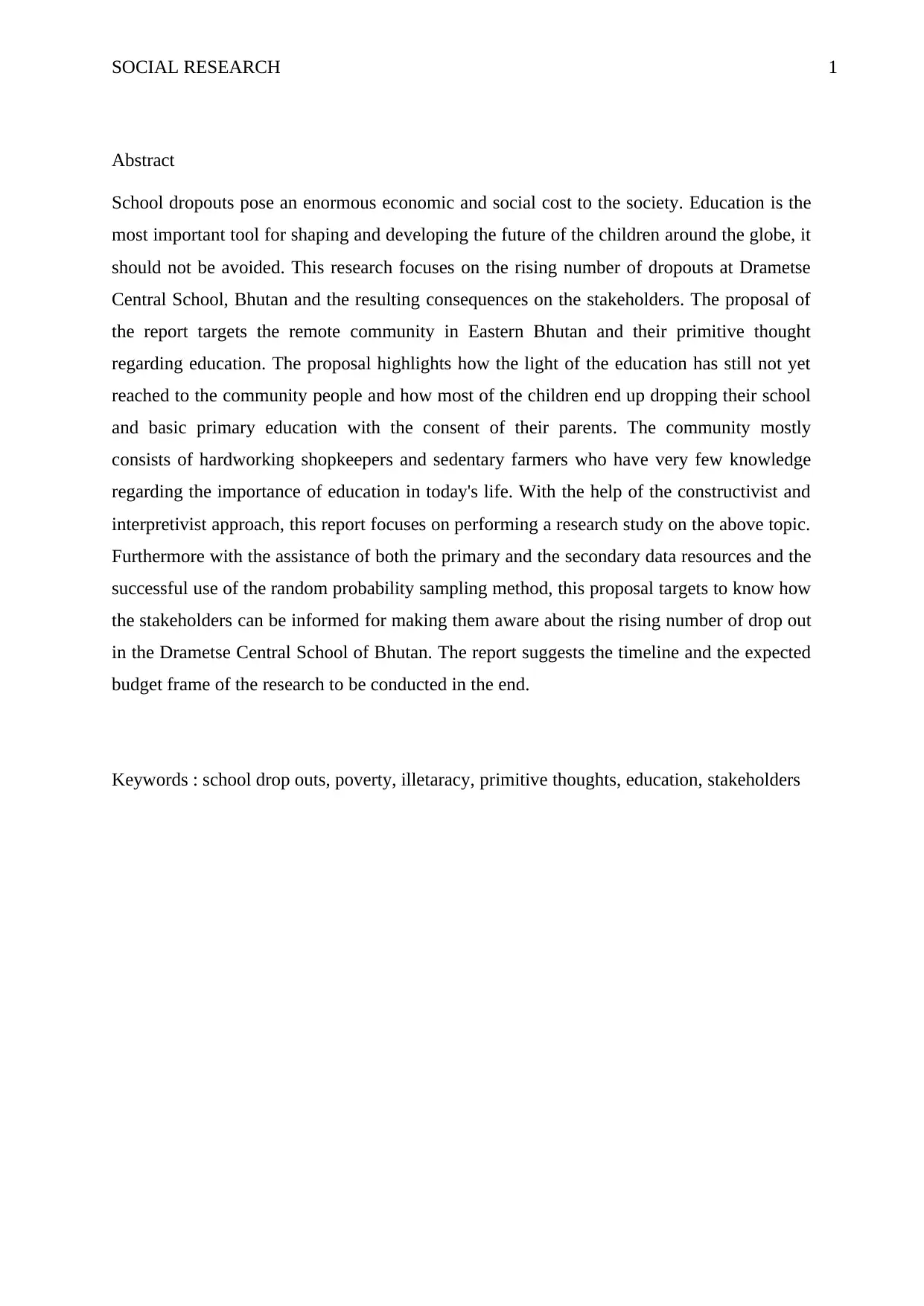
SOCIAL RESEARCH 1
Abstract
School dropouts pose an enormous economic and social cost to the society. Education is the
most important tool for shaping and developing the future of the children around the globe, it
should not be avoided. This research focuses on the rising number of dropouts at Drametse
Central School, Bhutan and the resulting consequences on the stakeholders. The proposal of
the report targets the remote community in Eastern Bhutan and their primitive thought
regarding education. The proposal highlights how the light of the education has still not yet
reached to the community people and how most of the children end up dropping their school
and basic primary education with the consent of their parents. The community mostly
consists of hardworking shopkeepers and sedentary farmers who have very few knowledge
regarding the importance of education in today's life. With the help of the constructivist and
interpretivist approach, this report focuses on performing a research study on the above topic.
Furthermore with the assistance of both the primary and the secondary data resources and the
successful use of the random probability sampling method, this proposal targets to know how
the stakeholders can be informed for making them aware about the rising number of drop out
in the Drametse Central School of Bhutan. The report suggests the timeline and the expected
budget frame of the research to be conducted in the end.
Keywords : school drop outs, poverty, illetaracy, primitive thoughts, education, stakeholders
Abstract
School dropouts pose an enormous economic and social cost to the society. Education is the
most important tool for shaping and developing the future of the children around the globe, it
should not be avoided. This research focuses on the rising number of dropouts at Drametse
Central School, Bhutan and the resulting consequences on the stakeholders. The proposal of
the report targets the remote community in Eastern Bhutan and their primitive thought
regarding education. The proposal highlights how the light of the education has still not yet
reached to the community people and how most of the children end up dropping their school
and basic primary education with the consent of their parents. The community mostly
consists of hardworking shopkeepers and sedentary farmers who have very few knowledge
regarding the importance of education in today's life. With the help of the constructivist and
interpretivist approach, this report focuses on performing a research study on the above topic.
Furthermore with the assistance of both the primary and the secondary data resources and the
successful use of the random probability sampling method, this proposal targets to know how
the stakeholders can be informed for making them aware about the rising number of drop out
in the Drametse Central School of Bhutan. The report suggests the timeline and the expected
budget frame of the research to be conducted in the end.
Keywords : school drop outs, poverty, illetaracy, primitive thoughts, education, stakeholders

SOCIAL RESEARCH 2
Table of Contents
Abstract......................................................................................................................................1
Chapter 1: Introduction..............................................................................................................3
1.1 Background of the study:.............................................................................................3
1.2 Statement of the problem:...........................................................................................3
1.3 Rationale of the research:............................................................................................4
1.4 Research aims and objectives:.....................................................................................4
Chapter 2: The Literature Review- Done By student.................................................................5
Chapter 3: The Research............................................................................................................8
3.1 Research Questions..........................................................................................................8
3.2 Research Methodology.....................................................................................................9
3.2.1 Research philosophy................................................................................................10
3.2.2 Research design.......................................................................................................10
3.2.3 Data collection method............................................................................................11
3.2.4 Sampling..................................................................................................................13
3.2.5 Ethical consideration of the Research......................................................................14
3.2.6 Research Limitation.................................................................................................15
Chapter 4: The Research Timeline...........................................................................................16
Chapter 5: Research Budget.....................................................................................................17
Chapter 6: Conclusion..............................................................................................................19
References................................................................................................................................20
Ethics Application Form..........................................................................................................24
Appendix..................................................................................................................................26
Table of Contents
Abstract......................................................................................................................................1
Chapter 1: Introduction..............................................................................................................3
1.1 Background of the study:.............................................................................................3
1.2 Statement of the problem:...........................................................................................3
1.3 Rationale of the research:............................................................................................4
1.4 Research aims and objectives:.....................................................................................4
Chapter 2: The Literature Review- Done By student.................................................................5
Chapter 3: The Research............................................................................................................8
3.1 Research Questions..........................................................................................................8
3.2 Research Methodology.....................................................................................................9
3.2.1 Research philosophy................................................................................................10
3.2.2 Research design.......................................................................................................10
3.2.3 Data collection method............................................................................................11
3.2.4 Sampling..................................................................................................................13
3.2.5 Ethical consideration of the Research......................................................................14
3.2.6 Research Limitation.................................................................................................15
Chapter 4: The Research Timeline...........................................................................................16
Chapter 5: Research Budget.....................................................................................................17
Chapter 6: Conclusion..............................................................................................................19
References................................................................................................................................20
Ethics Application Form..........................................................................................................24
Appendix..................................................................................................................................26
⊘ This is a preview!⊘
Do you want full access?
Subscribe today to unlock all pages.

Trusted by 1+ million students worldwide
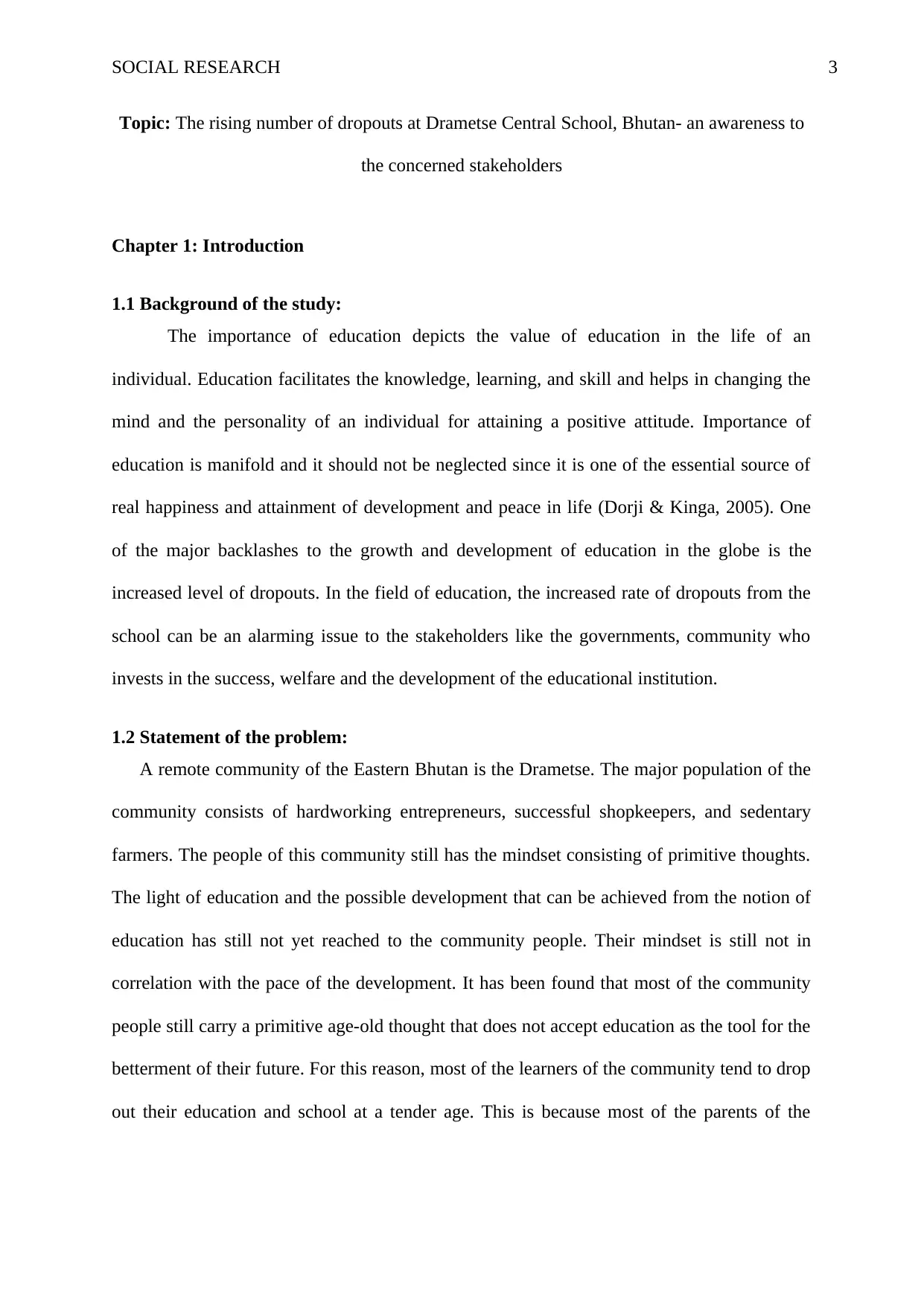
SOCIAL RESEARCH 3
Topic: The rising number of dropouts at Drametse Central School, Bhutan- an awareness to
the concerned stakeholders
Chapter 1: Introduction
1.1 Background of the study:
The importance of education depicts the value of education in the life of an
individual. Education facilitates the knowledge, learning, and skill and helps in changing the
mind and the personality of an individual for attaining a positive attitude. Importance of
education is manifold and it should not be neglected since it is one of the essential source of
real happiness and attainment of development and peace in life (Dorji & Kinga, 2005). One
of the major backlashes to the growth and development of education in the globe is the
increased level of dropouts. In the field of education, the increased rate of dropouts from the
school can be an alarming issue to the stakeholders like the governments, community who
invests in the success, welfare and the development of the educational institution.
1.2 Statement of the problem:
A remote community of the Eastern Bhutan is the Drametse. The major population of the
community consists of hardworking entrepreneurs, successful shopkeepers, and sedentary
farmers. The people of this community still has the mindset consisting of primitive thoughts.
The light of education and the possible development that can be achieved from the notion of
education has still not yet reached to the community people. Their mindset is still not in
correlation with the pace of the development. It has been found that most of the community
people still carry a primitive age-old thought that does not accept education as the tool for the
betterment of their future. For this reason, most of the learners of the community tend to drop
out their education and school at a tender age. This is because most of the parents of the
Topic: The rising number of dropouts at Drametse Central School, Bhutan- an awareness to
the concerned stakeholders
Chapter 1: Introduction
1.1 Background of the study:
The importance of education depicts the value of education in the life of an
individual. Education facilitates the knowledge, learning, and skill and helps in changing the
mind and the personality of an individual for attaining a positive attitude. Importance of
education is manifold and it should not be neglected since it is one of the essential source of
real happiness and attainment of development and peace in life (Dorji & Kinga, 2005). One
of the major backlashes to the growth and development of education in the globe is the
increased level of dropouts. In the field of education, the increased rate of dropouts from the
school can be an alarming issue to the stakeholders like the governments, community who
invests in the success, welfare and the development of the educational institution.
1.2 Statement of the problem:
A remote community of the Eastern Bhutan is the Drametse. The major population of the
community consists of hardworking entrepreneurs, successful shopkeepers, and sedentary
farmers. The people of this community still has the mindset consisting of primitive thoughts.
The light of education and the possible development that can be achieved from the notion of
education has still not yet reached to the community people. Their mindset is still not in
correlation with the pace of the development. It has been found that most of the community
people still carry a primitive age-old thought that does not accept education as the tool for the
betterment of their future. For this reason, most of the learners of the community tend to drop
out their education and school at a tender age. This is because most of the parents of the
Paraphrase This Document
Need a fresh take? Get an instant paraphrase of this document with our AI Paraphraser
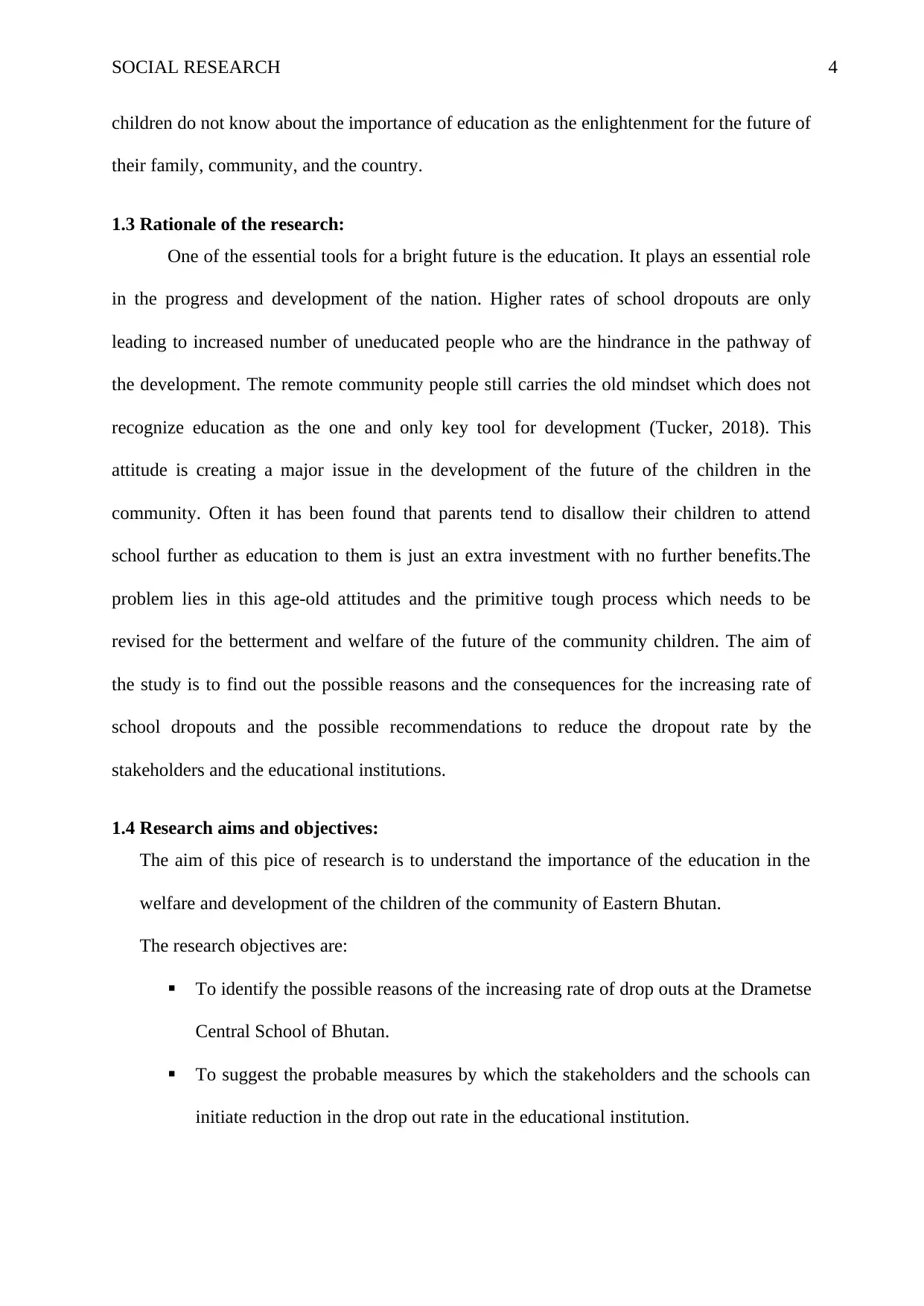
SOCIAL RESEARCH 4
children do not know about the importance of education as the enlightenment for the future of
their family, community, and the country.
1.3 Rationale of the research:
One of the essential tools for a bright future is the education. It plays an essential role
in the progress and development of the nation. Higher rates of school dropouts are only
leading to increased number of uneducated people who are the hindrance in the pathway of
the development. The remote community people still carries the old mindset which does not
recognize education as the one and only key tool for development (Tucker, 2018). This
attitude is creating a major issue in the development of the future of the children in the
community. Often it has been found that parents tend to disallow their children to attend
school further as education to them is just an extra investment with no further benefits.The
problem lies in this age-old attitudes and the primitive tough process which needs to be
revised for the betterment and welfare of the future of the community children. The aim of
the study is to find out the possible reasons and the consequences for the increasing rate of
school dropouts and the possible recommendations to reduce the dropout rate by the
stakeholders and the educational institutions.
1.4 Research aims and objectives:
The aim of this pice of research is to understand the importance of the education in the
welfare and development of the children of the community of Eastern Bhutan.
The research objectives are:
To identify the possible reasons of the increasing rate of drop outs at the Drametse
Central School of Bhutan.
To suggest the probable measures by which the stakeholders and the schools can
initiate reduction in the drop out rate in the educational institution.
children do not know about the importance of education as the enlightenment for the future of
their family, community, and the country.
1.3 Rationale of the research:
One of the essential tools for a bright future is the education. It plays an essential role
in the progress and development of the nation. Higher rates of school dropouts are only
leading to increased number of uneducated people who are the hindrance in the pathway of
the development. The remote community people still carries the old mindset which does not
recognize education as the one and only key tool for development (Tucker, 2018). This
attitude is creating a major issue in the development of the future of the children in the
community. Often it has been found that parents tend to disallow their children to attend
school further as education to them is just an extra investment with no further benefits.The
problem lies in this age-old attitudes and the primitive tough process which needs to be
revised for the betterment and welfare of the future of the community children. The aim of
the study is to find out the possible reasons and the consequences for the increasing rate of
school dropouts and the possible recommendations to reduce the dropout rate by the
stakeholders and the educational institutions.
1.4 Research aims and objectives:
The aim of this pice of research is to understand the importance of the education in the
welfare and development of the children of the community of Eastern Bhutan.
The research objectives are:
To identify the possible reasons of the increasing rate of drop outs at the Drametse
Central School of Bhutan.
To suggest the probable measures by which the stakeholders and the schools can
initiate reduction in the drop out rate in the educational institution.

SOCIAL RESEARCH 5
To understand the importance of education for the remote community of the
Eastern Bhutan for their success.
Chapter 2: The Literature Review- Done By student
Bhutan remained in isolation for many centuries with no or little developmental
activities. During early 1960’s with start of five-year developmental plan, modern education
became an inevitable tool for economic and social growth. The modern education started only
in 1960’s with inauguration of two schools. With the introduction of modern education
system, government realized its importance in economic growth and people too became
increasingly aware of its contribution in social development. As a result, number of student’s
enrollment increased from less than 400 in late 1960’s to 155,234 in 2004 (Dorji&
Kinga,2005). As per Annual Education Statistics (2016), at present there are 522 schools with
total students of 169560 from pre-primary to year XII.
A research on the Enrolment & Retention Strategies in Bhutan by Ministry of
Education reveals that though school dropout rate from pre-primary to year 10 has decreased
over a decade. The report also points out that net enrollment ratio (NER) decreases in lower
and middle schools . This indicates that the drop out number increases in lower and middle
secondary schools. Such trend may prove to be disastrous in long run.The ministry of
education during 11thfive-year plan targeted to achieve 100% enrollment in schools however,
such initiatives did not see much progress mainly due to drop outs (Cabus & De Witte, 2016).
As stated by Gyamtsho,Swabey and Pullen (2015) drop outs is a‘multifaceted
problem’. The studies all over the world found common reasons for drop outs, the family
related issues, poverty and personal problems. Witte, Cabus, Thyssen, Groot and Brink
(2013) argues that dropouts should not only be attributed to external factors such as family or
To understand the importance of education for the remote community of the
Eastern Bhutan for their success.
Chapter 2: The Literature Review- Done By student
Bhutan remained in isolation for many centuries with no or little developmental
activities. During early 1960’s with start of five-year developmental plan, modern education
became an inevitable tool for economic and social growth. The modern education started only
in 1960’s with inauguration of two schools. With the introduction of modern education
system, government realized its importance in economic growth and people too became
increasingly aware of its contribution in social development. As a result, number of student’s
enrollment increased from less than 400 in late 1960’s to 155,234 in 2004 (Dorji&
Kinga,2005). As per Annual Education Statistics (2016), at present there are 522 schools with
total students of 169560 from pre-primary to year XII.
A research on the Enrolment & Retention Strategies in Bhutan by Ministry of
Education reveals that though school dropout rate from pre-primary to year 10 has decreased
over a decade. The report also points out that net enrollment ratio (NER) decreases in lower
and middle schools . This indicates that the drop out number increases in lower and middle
secondary schools. Such trend may prove to be disastrous in long run.The ministry of
education during 11thfive-year plan targeted to achieve 100% enrollment in schools however,
such initiatives did not see much progress mainly due to drop outs (Cabus & De Witte, 2016).
As stated by Gyamtsho,Swabey and Pullen (2015) drop outs is a‘multifaceted
problem’. The studies all over the world found common reasons for drop outs, the family
related issues, poverty and personal problems. Witte, Cabus, Thyssen, Groot and Brink
(2013) argues that dropouts should not only be attributed to external factors such as family or
⊘ This is a preview!⊘
Do you want full access?
Subscribe today to unlock all pages.

Trusted by 1+ million students worldwide
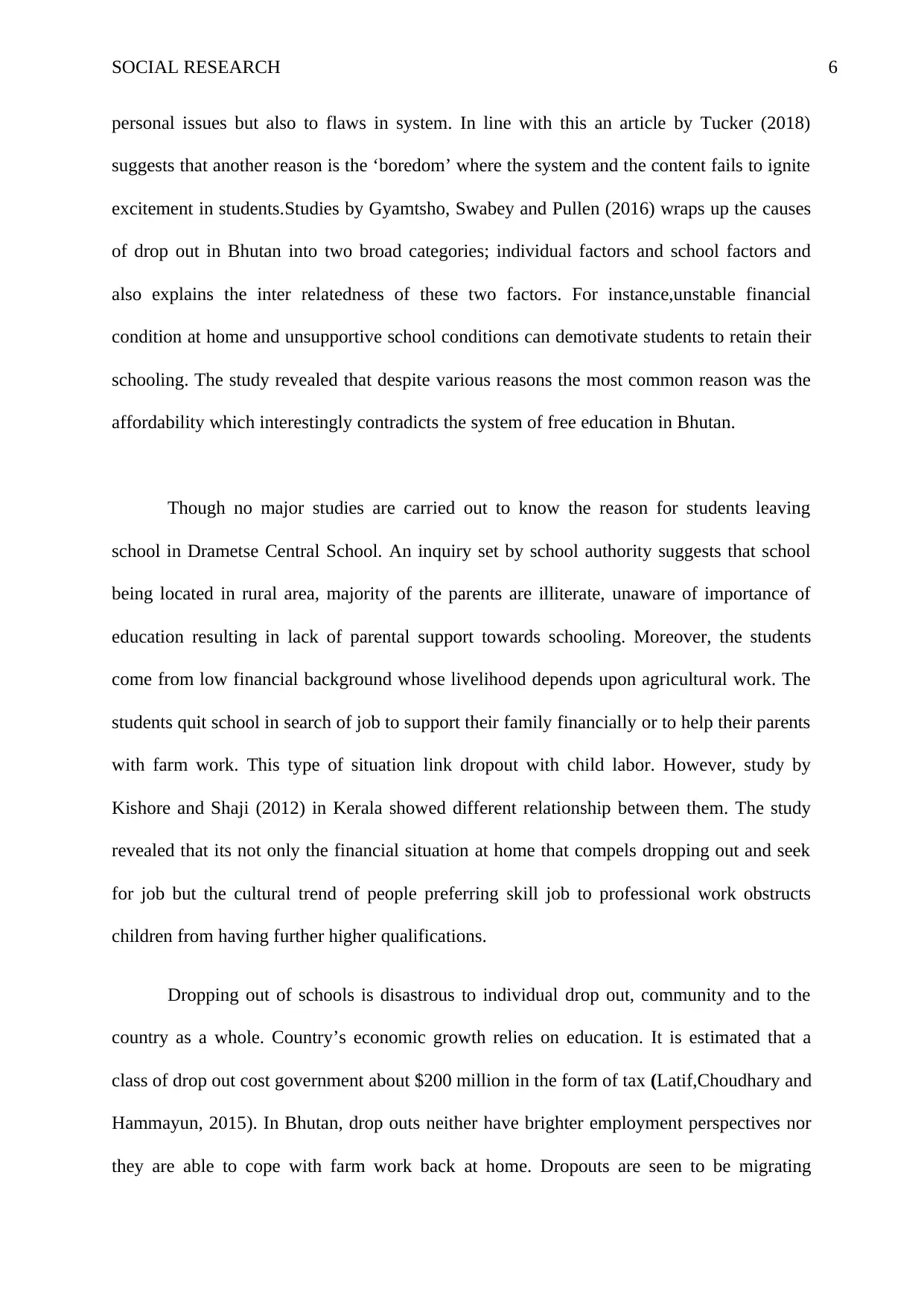
SOCIAL RESEARCH 6
personal issues but also to flaws in system. In line with this an article by Tucker (2018)
suggests that another reason is the ‘boredom’ where the system and the content fails to ignite
excitement in students.Studies by Gyamtsho, Swabey and Pullen (2016) wraps up the causes
of drop out in Bhutan into two broad categories; individual factors and school factors and
also explains the inter relatedness of these two factors. For instance,unstable financial
condition at home and unsupportive school conditions can demotivate students to retain their
schooling. The study revealed that despite various reasons the most common reason was the
affordability which interestingly contradicts the system of free education in Bhutan.
Though no major studies are carried out to know the reason for students leaving
school in Drametse Central School. An inquiry set by school authority suggests that school
being located in rural area, majority of the parents are illiterate, unaware of importance of
education resulting in lack of parental support towards schooling. Moreover, the students
come from low financial background whose livelihood depends upon agricultural work. The
students quit school in search of job to support their family financially or to help their parents
with farm work. This type of situation link dropout with child labor. However, study by
Kishore and Shaji (2012) in Kerala showed different relationship between them. The study
revealed that its not only the financial situation at home that compels dropping out and seek
for job but the cultural trend of people preferring skill job to professional work obstructs
children from having further higher qualifications.
Dropping out of schools is disastrous to individual drop out, community and to the
country as a whole. Country’s economic growth relies on education. It is estimated that a
class of drop out cost government about $200 million in the form of tax (Latif,Choudhary and
Hammayun, 2015). In Bhutan, drop outs neither have brighter employment perspectives nor
they are able to cope with farm work back at home. Dropouts are seen to be migrating
personal issues but also to flaws in system. In line with this an article by Tucker (2018)
suggests that another reason is the ‘boredom’ where the system and the content fails to ignite
excitement in students.Studies by Gyamtsho, Swabey and Pullen (2016) wraps up the causes
of drop out in Bhutan into two broad categories; individual factors and school factors and
also explains the inter relatedness of these two factors. For instance,unstable financial
condition at home and unsupportive school conditions can demotivate students to retain their
schooling. The study revealed that despite various reasons the most common reason was the
affordability which interestingly contradicts the system of free education in Bhutan.
Though no major studies are carried out to know the reason for students leaving
school in Drametse Central School. An inquiry set by school authority suggests that school
being located in rural area, majority of the parents are illiterate, unaware of importance of
education resulting in lack of parental support towards schooling. Moreover, the students
come from low financial background whose livelihood depends upon agricultural work. The
students quit school in search of job to support their family financially or to help their parents
with farm work. This type of situation link dropout with child labor. However, study by
Kishore and Shaji (2012) in Kerala showed different relationship between them. The study
revealed that its not only the financial situation at home that compels dropping out and seek
for job but the cultural trend of people preferring skill job to professional work obstructs
children from having further higher qualifications.
Dropping out of schools is disastrous to individual drop out, community and to the
country as a whole. Country’s economic growth relies on education. It is estimated that a
class of drop out cost government about $200 million in the form of tax (Latif,Choudhary and
Hammayun, 2015). In Bhutan, drop outs neither have brighter employment perspectives nor
they are able to cope with farm work back at home. Dropouts are seen to be migrating
Paraphrase This Document
Need a fresh take? Get an instant paraphrase of this document with our AI Paraphraser
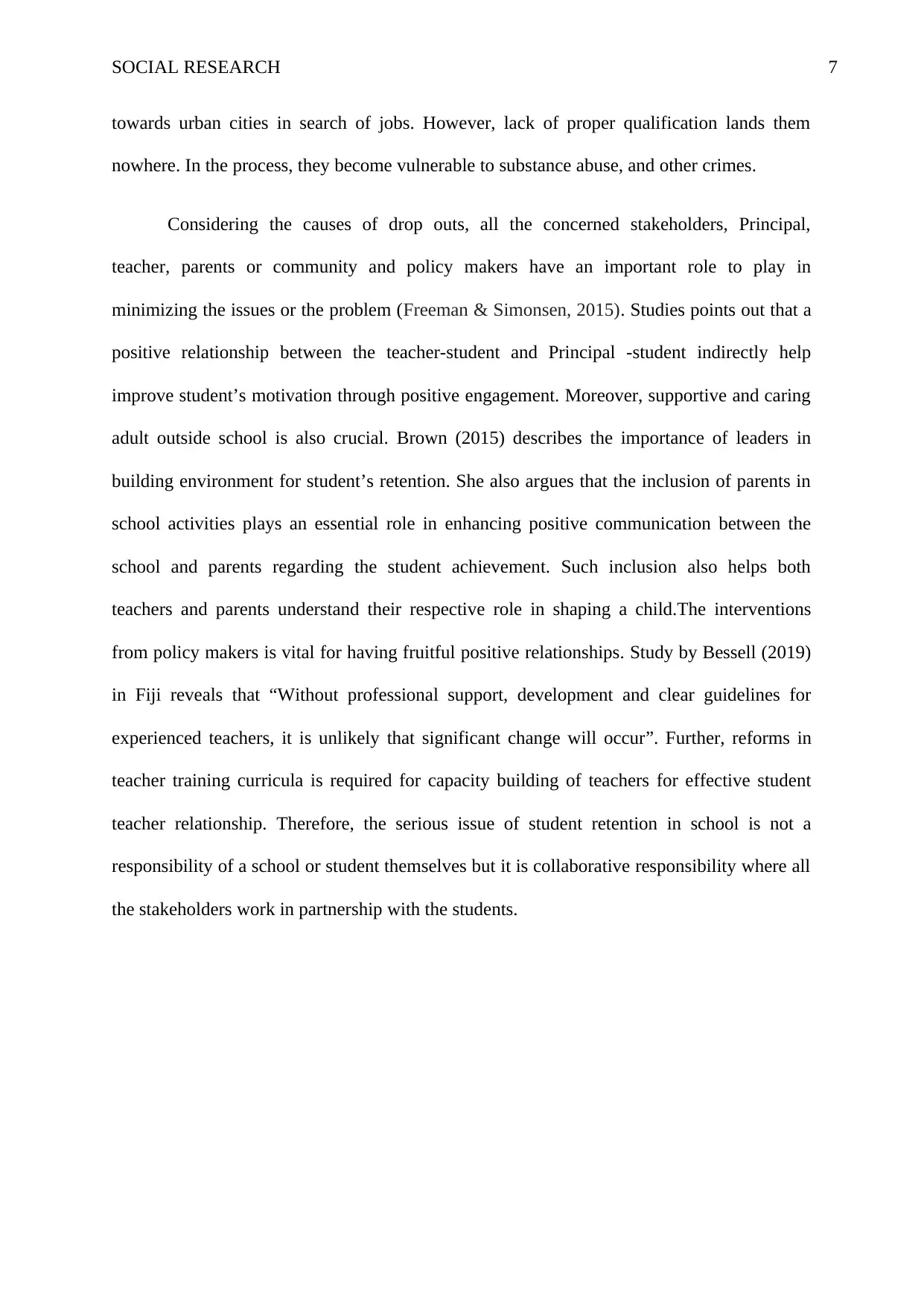
SOCIAL RESEARCH 7
towards urban cities in search of jobs. However, lack of proper qualification lands them
nowhere. In the process, they become vulnerable to substance abuse, and other crimes.
Considering the causes of drop outs, all the concerned stakeholders, Principal,
teacher, parents or community and policy makers have an important role to play in
minimizing the issues or the problem (Freeman & Simonsen, 2015). Studies points out that a
positive relationship between the teacher-student and Principal -student indirectly help
improve student’s motivation through positive engagement. Moreover, supportive and caring
adult outside school is also crucial. Brown (2015) describes the importance of leaders in
building environment for student’s retention. She also argues that the inclusion of parents in
school activities plays an essential role in enhancing positive communication between the
school and parents regarding the student achievement. Such inclusion also helps both
teachers and parents understand their respective role in shaping a child.The interventions
from policy makers is vital for having fruitful positive relationships. Study by Bessell (2019)
in Fiji reveals that “Without professional support, development and clear guidelines for
experienced teachers, it is unlikely that significant change will occur”. Further, reforms in
teacher training curricula is required for capacity building of teachers for effective student
teacher relationship. Therefore, the serious issue of student retention in school is not a
responsibility of a school or student themselves but it is collaborative responsibility where all
the stakeholders work in partnership with the students.
towards urban cities in search of jobs. However, lack of proper qualification lands them
nowhere. In the process, they become vulnerable to substance abuse, and other crimes.
Considering the causes of drop outs, all the concerned stakeholders, Principal,
teacher, parents or community and policy makers have an important role to play in
minimizing the issues or the problem (Freeman & Simonsen, 2015). Studies points out that a
positive relationship between the teacher-student and Principal -student indirectly help
improve student’s motivation through positive engagement. Moreover, supportive and caring
adult outside school is also crucial. Brown (2015) describes the importance of leaders in
building environment for student’s retention. She also argues that the inclusion of parents in
school activities plays an essential role in enhancing positive communication between the
school and parents regarding the student achievement. Such inclusion also helps both
teachers and parents understand their respective role in shaping a child.The interventions
from policy makers is vital for having fruitful positive relationships. Study by Bessell (2019)
in Fiji reveals that “Without professional support, development and clear guidelines for
experienced teachers, it is unlikely that significant change will occur”. Further, reforms in
teacher training curricula is required for capacity building of teachers for effective student
teacher relationship. Therefore, the serious issue of student retention in school is not a
responsibility of a school or student themselves but it is collaborative responsibility where all
the stakeholders work in partnership with the students.
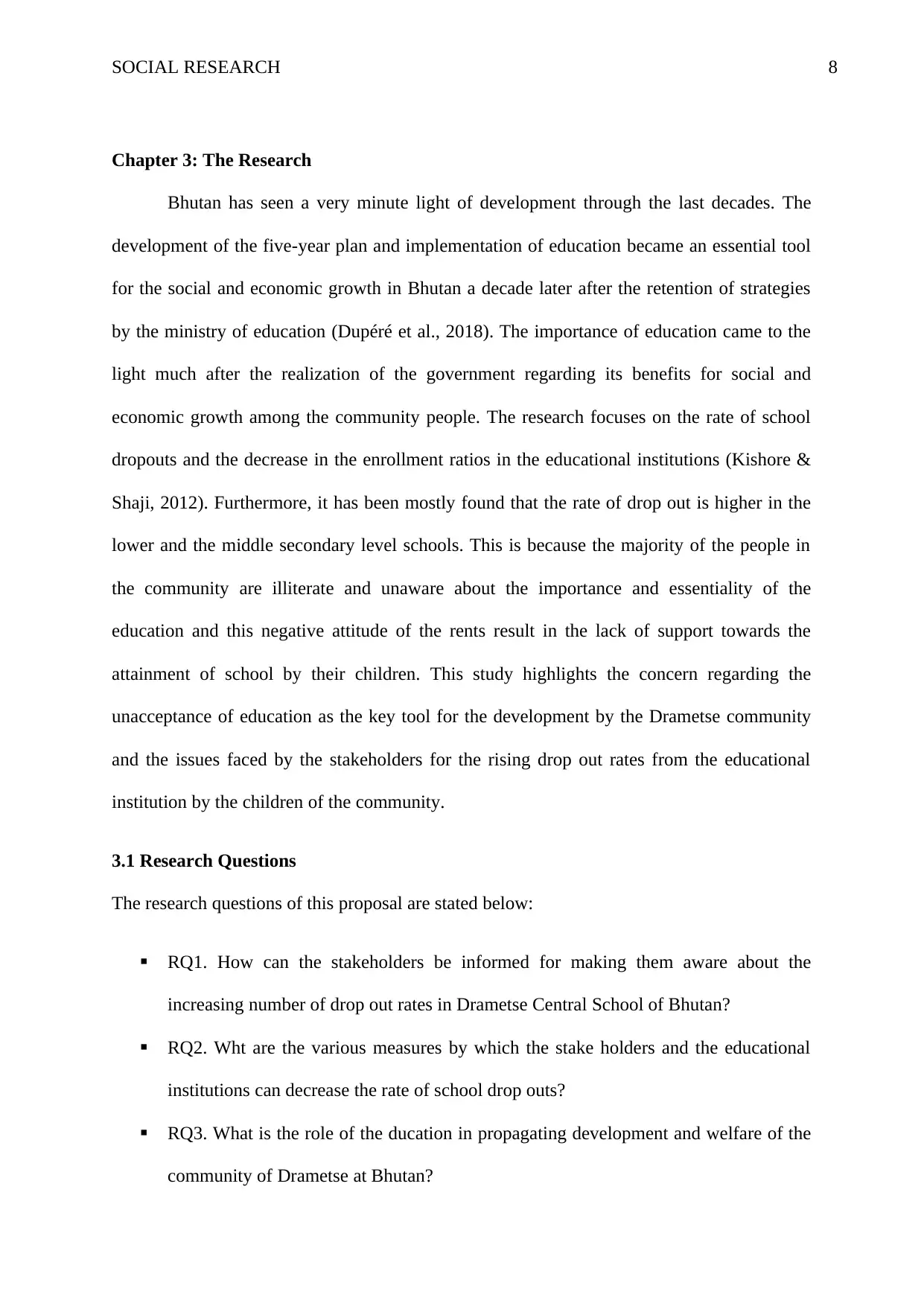
SOCIAL RESEARCH 8
Chapter 3: The Research
Bhutan has seen a very minute light of development through the last decades. The
development of the five-year plan and implementation of education became an essential tool
for the social and economic growth in Bhutan a decade later after the retention of strategies
by the ministry of education (Dupéré et al., 2018). The importance of education came to the
light much after the realization of the government regarding its benefits for social and
economic growth among the community people. The research focuses on the rate of school
dropouts and the decrease in the enrollment ratios in the educational institutions (Kishore &
Shaji, 2012). Furthermore, it has been mostly found that the rate of drop out is higher in the
lower and the middle secondary level schools. This is because the majority of the people in
the community are illiterate and unaware about the importance and essentiality of the
education and this negative attitude of the rents result in the lack of support towards the
attainment of school by their children. This study highlights the concern regarding the
unacceptance of education as the key tool for the development by the Drametse community
and the issues faced by the stakeholders for the rising drop out rates from the educational
institution by the children of the community.
3.1 Research Questions
The research questions of this proposal are stated below:
RQ1. How can the stakeholders be informed for making them aware about the
increasing number of drop out rates in Drametse Central School of Bhutan?
RQ2. Wht are the various measures by which the stake holders and the educational
institutions can decrease the rate of school drop outs?
RQ3. What is the role of the ducation in propagating development and welfare of the
community of Drametse at Bhutan?
Chapter 3: The Research
Bhutan has seen a very minute light of development through the last decades. The
development of the five-year plan and implementation of education became an essential tool
for the social and economic growth in Bhutan a decade later after the retention of strategies
by the ministry of education (Dupéré et al., 2018). The importance of education came to the
light much after the realization of the government regarding its benefits for social and
economic growth among the community people. The research focuses on the rate of school
dropouts and the decrease in the enrollment ratios in the educational institutions (Kishore &
Shaji, 2012). Furthermore, it has been mostly found that the rate of drop out is higher in the
lower and the middle secondary level schools. This is because the majority of the people in
the community are illiterate and unaware about the importance and essentiality of the
education and this negative attitude of the rents result in the lack of support towards the
attainment of school by their children. This study highlights the concern regarding the
unacceptance of education as the key tool for the development by the Drametse community
and the issues faced by the stakeholders for the rising drop out rates from the educational
institution by the children of the community.
3.1 Research Questions
The research questions of this proposal are stated below:
RQ1. How can the stakeholders be informed for making them aware about the
increasing number of drop out rates in Drametse Central School of Bhutan?
RQ2. Wht are the various measures by which the stake holders and the educational
institutions can decrease the rate of school drop outs?
RQ3. What is the role of the ducation in propagating development and welfare of the
community of Drametse at Bhutan?
⊘ This is a preview!⊘
Do you want full access?
Subscribe today to unlock all pages.

Trusted by 1+ million students worldwide
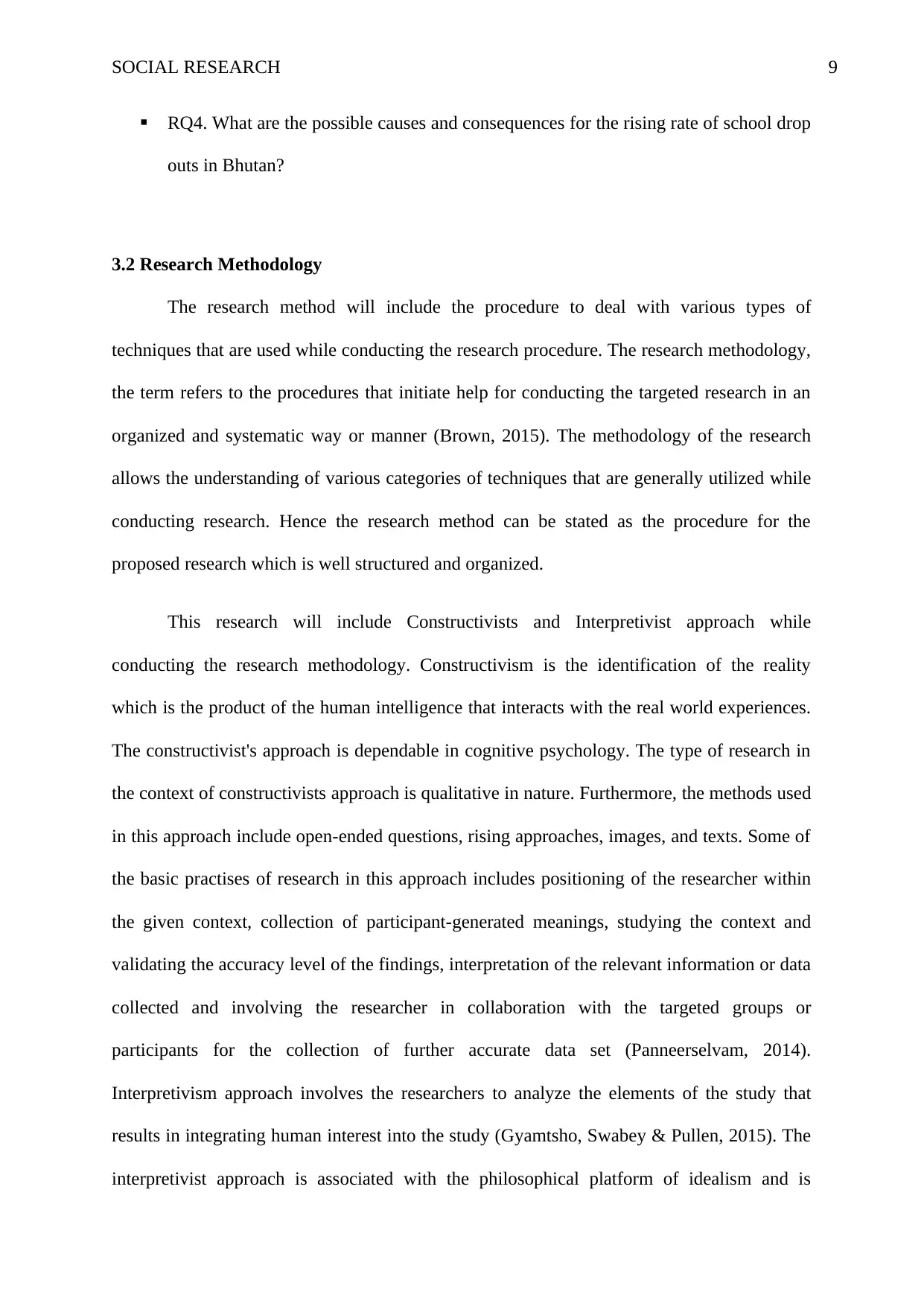
SOCIAL RESEARCH 9
RQ4. What are the possible causes and consequences for the rising rate of school drop
outs in Bhutan?
3.2 Research Methodology
The research method will include the procedure to deal with various types of
techniques that are used while conducting the research procedure. The research methodology,
the term refers to the procedures that initiate help for conducting the targeted research in an
organized and systematic way or manner (Brown, 2015). The methodology of the research
allows the understanding of various categories of techniques that are generally utilized while
conducting research. Hence the research method can be stated as the procedure for the
proposed research which is well structured and organized.
This research will include Constructivists and Interpretivist approach while
conducting the research methodology. Constructivism is the identification of the reality
which is the product of the human intelligence that interacts with the real world experiences.
The constructivist's approach is dependable in cognitive psychology. The type of research in
the context of constructivists approach is qualitative in nature. Furthermore, the methods used
in this approach include open-ended questions, rising approaches, images, and texts. Some of
the basic practises of research in this approach includes positioning of the researcher within
the given context, collection of participant-generated meanings, studying the context and
validating the accuracy level of the findings, interpretation of the relevant information or data
collected and involving the researcher in collaboration with the targeted groups or
participants for the collection of further accurate data set (Panneerselvam, 2014).
Interpretivism approach involves the researchers to analyze the elements of the study that
results in integrating human interest into the study (Gyamtsho, Swabey & Pullen, 2015). The
interpretivist approach is associated with the philosophical platform of idealism and is
RQ4. What are the possible causes and consequences for the rising rate of school drop
outs in Bhutan?
3.2 Research Methodology
The research method will include the procedure to deal with various types of
techniques that are used while conducting the research procedure. The research methodology,
the term refers to the procedures that initiate help for conducting the targeted research in an
organized and systematic way or manner (Brown, 2015). The methodology of the research
allows the understanding of various categories of techniques that are generally utilized while
conducting research. Hence the research method can be stated as the procedure for the
proposed research which is well structured and organized.
This research will include Constructivists and Interpretivist approach while
conducting the research methodology. Constructivism is the identification of the reality
which is the product of the human intelligence that interacts with the real world experiences.
The constructivist's approach is dependable in cognitive psychology. The type of research in
the context of constructivists approach is qualitative in nature. Furthermore, the methods used
in this approach include open-ended questions, rising approaches, images, and texts. Some of
the basic practises of research in this approach includes positioning of the researcher within
the given context, collection of participant-generated meanings, studying the context and
validating the accuracy level of the findings, interpretation of the relevant information or data
collected and involving the researcher in collaboration with the targeted groups or
participants for the collection of further accurate data set (Panneerselvam, 2014).
Interpretivism approach involves the researchers to analyze the elements of the study that
results in integrating human interest into the study (Gyamtsho, Swabey & Pullen, 2015). The
interpretivist approach is associated with the philosophical platform of idealism and is
Paraphrase This Document
Need a fresh take? Get an instant paraphrase of this document with our AI Paraphraser
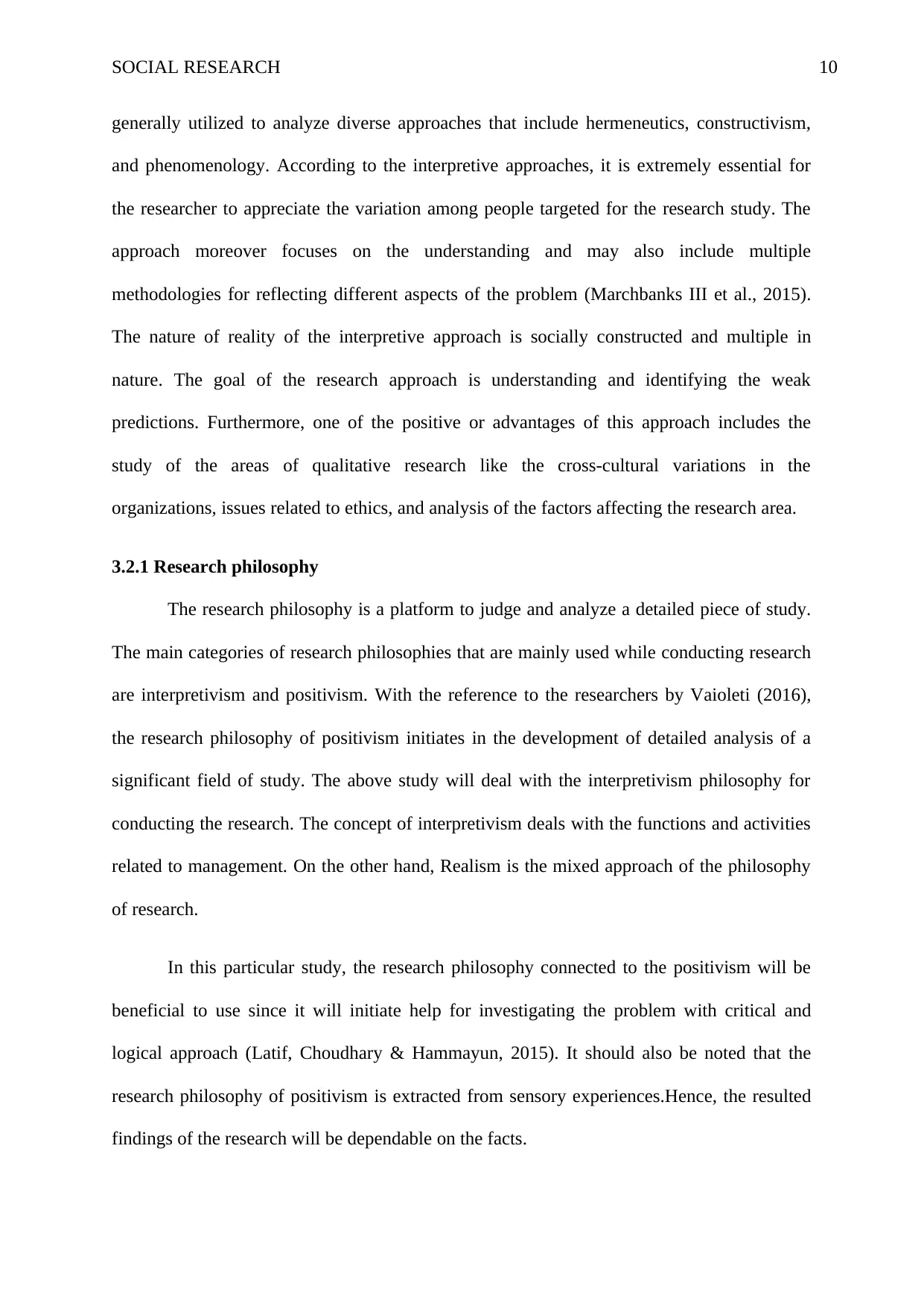
SOCIAL RESEARCH 10
generally utilized to analyze diverse approaches that include hermeneutics, constructivism,
and phenomenology. According to the interpretive approaches, it is extremely essential for
the researcher to appreciate the variation among people targeted for the research study. The
approach moreover focuses on the understanding and may also include multiple
methodologies for reflecting different aspects of the problem (Marchbanks III et al., 2015).
The nature of reality of the interpretive approach is socially constructed and multiple in
nature. The goal of the research approach is understanding and identifying the weak
predictions. Furthermore, one of the positive or advantages of this approach includes the
study of the areas of qualitative research like the cross-cultural variations in the
organizations, issues related to ethics, and analysis of the factors affecting the research area.
3.2.1 Research philosophy
The research philosophy is a platform to judge and analyze a detailed piece of study.
The main categories of research philosophies that are mainly used while conducting research
are interpretivism and positivism. With the reference to the researchers by Vaioleti (2016),
the research philosophy of positivism initiates in the development of detailed analysis of a
significant field of study. The above study will deal with the interpretivism philosophy for
conducting the research. The concept of interpretivism deals with the functions and activities
related to management. On the other hand, Realism is the mixed approach of the philosophy
of research.
In this particular study, the research philosophy connected to the positivism will be
beneficial to use since it will initiate help for investigating the problem with critical and
logical approach (Latif, Choudhary & Hammayun, 2015). It should also be noted that the
research philosophy of positivism is extracted from sensory experiences.Hence, the resulted
findings of the research will be dependable on the facts.
generally utilized to analyze diverse approaches that include hermeneutics, constructivism,
and phenomenology. According to the interpretive approaches, it is extremely essential for
the researcher to appreciate the variation among people targeted for the research study. The
approach moreover focuses on the understanding and may also include multiple
methodologies for reflecting different aspects of the problem (Marchbanks III et al., 2015).
The nature of reality of the interpretive approach is socially constructed and multiple in
nature. The goal of the research approach is understanding and identifying the weak
predictions. Furthermore, one of the positive or advantages of this approach includes the
study of the areas of qualitative research like the cross-cultural variations in the
organizations, issues related to ethics, and analysis of the factors affecting the research area.
3.2.1 Research philosophy
The research philosophy is a platform to judge and analyze a detailed piece of study.
The main categories of research philosophies that are mainly used while conducting research
are interpretivism and positivism. With the reference to the researchers by Vaioleti (2016),
the research philosophy of positivism initiates in the development of detailed analysis of a
significant field of study. The above study will deal with the interpretivism philosophy for
conducting the research. The concept of interpretivism deals with the functions and activities
related to management. On the other hand, Realism is the mixed approach of the philosophy
of research.
In this particular study, the research philosophy connected to the positivism will be
beneficial to use since it will initiate help for investigating the problem with critical and
logical approach (Latif, Choudhary & Hammayun, 2015). It should also be noted that the
research philosophy of positivism is extracted from sensory experiences.Hence, the resulted
findings of the research will be dependable on the facts.

DATA COLLECTION METHOD
PRIMARY DATA
COLLECTION
SECONDARY DATA
COLLECTION
SOCIAL RESEARCH 11
3.2.2 Research design
Analytical or descriptive, explanatory and exploratory are the three major types of the
designs of the research. Among all of these, the analytical research design is helpful for
understanding and evaluating the research in a descriptive manner (Simonsohn, Nelson &
Simmons, 2017). The exploratory design is basically used for the understanding of the
concept at preliminary stage during the research process and that of exploratory design is
utilized for developing and forming a connection among the two variables that are taken
under the consideration. In case of the current study, analytical research design will be
utilized for the research for gaining detailed ideas regarding the concepts and theories of the
research study.
3.2.3 Data collection method
This particular research will rely on the accumulation and collection of secondary and
primary data sources. While conducting the research,primary data will be collected on the
basis of various resources namely by survey method, interviews and secondary reliable
sources that will include all relevant categories of data, available both in printed form and in
the online platforms. While carrying out this particular research study, both of the data will
be used efficiently.
PRIMARY DATA
COLLECTION
SECONDARY DATA
COLLECTION
SOCIAL RESEARCH 11
3.2.2 Research design
Analytical or descriptive, explanatory and exploratory are the three major types of the
designs of the research. Among all of these, the analytical research design is helpful for
understanding and evaluating the research in a descriptive manner (Simonsohn, Nelson &
Simmons, 2017). The exploratory design is basically used for the understanding of the
concept at preliminary stage during the research process and that of exploratory design is
utilized for developing and forming a connection among the two variables that are taken
under the consideration. In case of the current study, analytical research design will be
utilized for the research for gaining detailed ideas regarding the concepts and theories of the
research study.
3.2.3 Data collection method
This particular research will rely on the accumulation and collection of secondary and
primary data sources. While conducting the research,primary data will be collected on the
basis of various resources namely by survey method, interviews and secondary reliable
sources that will include all relevant categories of data, available both in printed form and in
the online platforms. While carrying out this particular research study, both of the data will
be used efficiently.
⊘ This is a preview!⊘
Do you want full access?
Subscribe today to unlock all pages.

Trusted by 1+ million students worldwide
1 out of 28
Your All-in-One AI-Powered Toolkit for Academic Success.
+13062052269
info@desklib.com
Available 24*7 on WhatsApp / Email
![[object Object]](/_next/static/media/star-bottom.7253800d.svg)
Unlock your academic potential
Copyright © 2020–2025 A2Z Services. All Rights Reserved. Developed and managed by ZUCOL.


